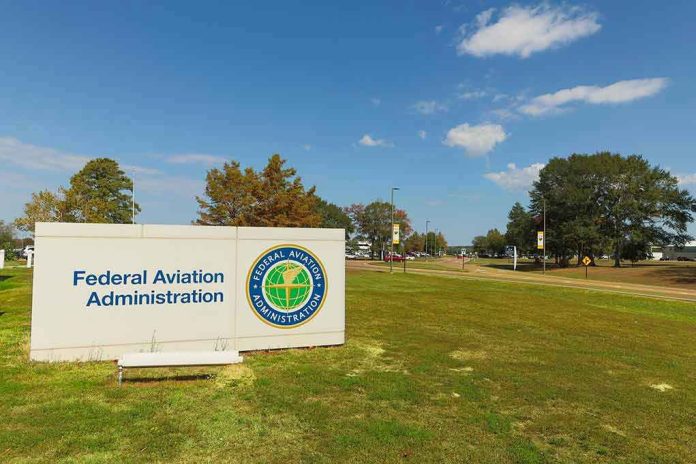
America’s travel infrastructure faces a new crisis as the FAA’s controller shortage triggers flight delays and exposes the consequences of years of mismanagement and government neglect.
Story Highlights
- Over 40% of U.S. air traffic control towers are understaffed, risking safety and causing widespread flight disruptions.
- FAA launches an unprecedented plan to hire 8,900 new controllers by 2028, aiming to restore operational reliability.
- Temporary flight reductions at 40 major airports have been implemented to manage the shortage’s risks.
- Pandemic-era policies and bureaucratic bottlenecks are blamed for the crisis, fueling public frustration and calls for real reform.
FAA Controller Shortage Reaches Critical Levels
The Federal Aviation Administration (FAA) now confronts a historic staffing emergency, with more than 40% of America’s control towers dangerously understaffed as 2024 closed. This crisis has resulted in flight delays, increased workload for controllers, and mounting risks to the safety and efficiency of the national airspace system.
The shortage, rooted in years of government mismanagement and exacerbated by the COVID-19 pandemic’s disruption of the training pipeline, leaves millions of travelers and airlines in limbo as operational reliability falters.
In response to the crisis, the FAA announced plans to hire 8,900 new air traffic controllers by 2028. This aggressive recruitment drive marks the largest workforce expansion in agency history. The FAA exceeded its hiring goals in both fiscal years 2024 and 2025 and intends to hire 2,200 more controllers in 2026.
However, training remains a significant challenge, as it typically takes two to three years for recruits to reach full qualification. The agency is implementing reforms to accelerate recruitment, expand academy capacity, and upgrade simulation technology, but bottlenecks persist as attrition outpaces new hires.
Temporary Flight Reductions and Structural Reforms
To manage immediate operational risks, the Department of Transportation and FAA announced a 10% reduction in flights at 40 major airports in November 2025. This drastic measure is intended to prevent unsafe working conditions and further disruptions, but underscores the severity of the crisis.
Some facilities are now intentionally overstaffed to anticipate future retirements and attrition, while others struggle to maintain minimum safe staffing. The FAA’s new workforce plan calls for year-round hiring, streamlined training processes, and enhanced use of technology—yet the multi-year nature of controller training means relief will not come overnight.
Industry experts, unions, and analysts warn that these reforms are necessary but may prove insufficient unless broader changes are made to FAA recruitment and training infrastructure. The National Air Traffic Controllers Association (NATCA) cautions that overwork and understaffing could compromise safety and increase stress on the workforce.
While some advocate for technological solutions like automation and artificial intelligence, most agree that highly trained professionals remain irreplaceable for complex airspace management. The crisis has prompted renewed scrutiny of government workforce planning, with critics pointing to bureaucratic delays and fiscal mismanagement under previous administrations as root causes.
Economic, Social, and Political Impact
Americans are already feeling the effects of the shortage, with flight delays, cancellations, and travel uncertainty on the rise. The economic ripple effects extend to airlines, airports, cargo, logistics, and tourism sectors, threatening jobs and local economies nationwide.
Political pressure is building on the FAA and DOT to resolve the crisis, as frustrated travelers and industry leaders demand accountability and swift action. Social stress among air traffic controllers is rising, with concerns about burnout and job security mounting. Long-term, there is a risk of eroding public confidence in the reliability of U.S. air travel if solutions lag behind attrition.
FAA scrambles to hire 8,900 air traffic controllers by 2028 as shortage reaches crisis levels https://t.co/37pk49n9NK #FoxNews
— Joni Myers (@JoniMyers18) November 24, 2025
The current administration faces a clear mandate: restore operational reliability and protect the integrity of America’s transportation system. The FAA’s ambitious hiring plan is a necessary step, but lasting change will require sustained investment, innovation, and a commitment to core values—efficiency, safety, and responsible stewardship.
As the controller shortage exposes the consequences of government overreach and neglect, conservative Americans are right to demand reforms that prioritize accountability and common-sense management of the nation’s vital infrastructure.
Sources:
Is There a Shortage of Air Traffic Controllers?
DOT, FAA Announce Temporary 10% Reduction in Flights at 40 Airports





